
There are many superb websites with links for plant identification but GPIK is focused on:
1) ornamental garden plants including turf and houseplants
2) 100% free keys
3)"always available anywhere and everywhere", no web connection needed, downloaded PDF keys and books stored on local, high portable and durable devices. I do not discount the advantage of interactive, complex, polyclave or new tech online keys and I use them regularly in a number of plant groups and genera. Many online ID apps are nearly impossible to use on a phone, let alone when you are half way up a muddy hill in some jungle-like arboretum, birds pooping on your head and dive-bombing you along with angry squirrels ready gnaw your face off, trying to find the remains of just one seedpod or determine leaf vein axil vestitute on a dank, cloudy day with a swirling, ominous thunderstorm about 5 minutes out, booming it's impending ability to soak you and your fancy electronic ID thingie. I've tested many keys out in that and many worse circumstances on smart phones, tablets, and laptops to get the results that follow. Many online ID apps (none listed here) were done by students as one-off, never-updated degree projects and well meaning extension folks trying to meet a metric and seem hip and relevent. Most of those work at a very basic, novice level and the chance of all your species (even at the average garden center) being on their apps is about...zero. When they offer three maple species and just one oak....I'm going elsewhere. PRINCIPLE ONE: It's the readily found taxa you don't include that make a key worthless and misleading.
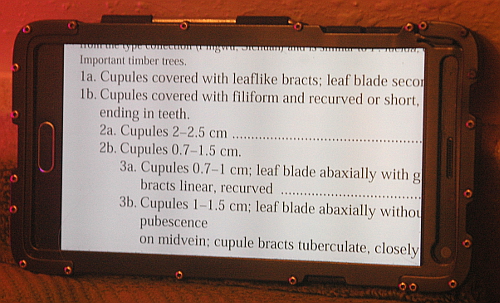
Samsung Galaxy Note 4 phone in a ballistic case (for hard botanizing and vast arboretum trekking) showing a portion of a Flora of China PDF key. You zoom in and out with fingers as well as move sections over as needed. Ten years ago everyone thought a phone was a phone and not a way to tell you what plant you have before you.
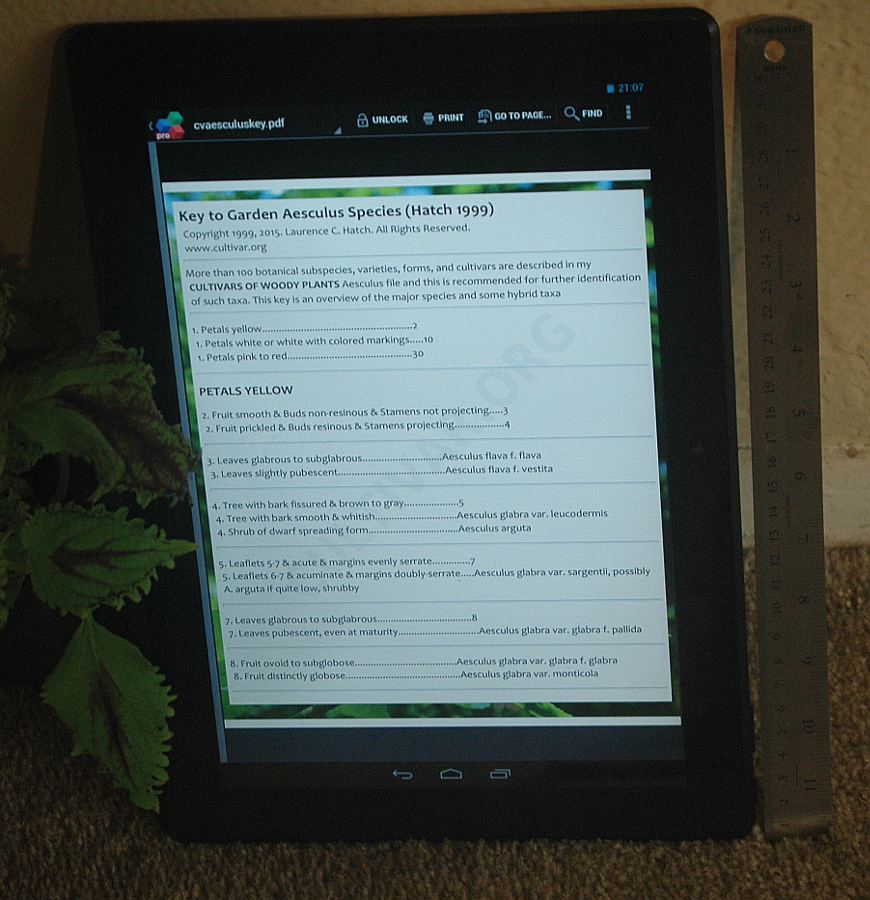
Azpen Android 13.3 inch tablet showing my own Aesculus key in a very good, useful size for field work.
Phone issues: Different phone makers and providers give different obstacles to loading PDF files on your phone. Often these greedy folks want to sell you a plant book rather than have you buy it elsewhere or get a free, legal copy from Google, Archive.org, or your favorite website. Typically it is a good idea to download the PDF files first to your main computer (or wherever your internet minutes are the cheapest - yes these keys will take an hour or ten for a full collection), sync it to your device later with a cable, and send the files to a directory there for viewing. Getting a signal in the middle of many gardens, nurseries, or arboreta can be a tricky thing so having the PDF local to your device makes them always available 100% of the time and for cost per use. Most of the time it's Apple iPhones which give people fits for putting PDF keys on the device. This article may help and it assuredly not you the user who are a dummy: http://www.dummies.com/how-to/content/how-to-transfer-pdfs-to-an-iphone.html . Frankly, I avoid the tree of good and evil and their tempting phones. I recently switched my PDF keys (including some large floras and monographs) from an old, original B&W Nook to a Samsung Galaxy Note 4 and simply dropped the microcard from the first into the second. All my 440 books including beloved plant keys were immediately available and in even better resolution now. Not all the phone makers and carriers are going to let you do that.
Tell us your portable ID key stories, experiences, frustrations, successed, ideas - suitable for posting: ornamentals @ lycos.com
 |
- Efloras.org: Floras of North America, China, and other locales: Go to http://www.efloras.org/
and enter a genus name in the search box, checking "all floras". We
generally find the North American and Chinese floras to be the most
rich for garden taxa. Click on their PDF link under Related Objects and
download where desired. You might start with the genera Acer,
Corylopsis, Buddleia, and Quercus. If you prefer to go alphabetically
and not search then go to http://www.cultivar.org and click our links under the
 logo.
logo. - My
much abused Samsung Galaxy Note 4 showing a wider view of the same Flora of China key
shown above, allowing me to move quickly and then later magnify a
particular section when the key details get dense and serious.

- The
Flora of China Nyssa page in full size (about 8.5 in. x 11 in.) this
massive 13.3 inch Azpen Android tablet. It 's useful to see the entire
page for context.

- And
if you want to examine the key itself is larger print this shot with
the tablet held another way is useful. Thge pink and aqua bands are
created by the tablet's graphics not exactly matching the camera's
shutter speed. They do not exist in real life viewing.
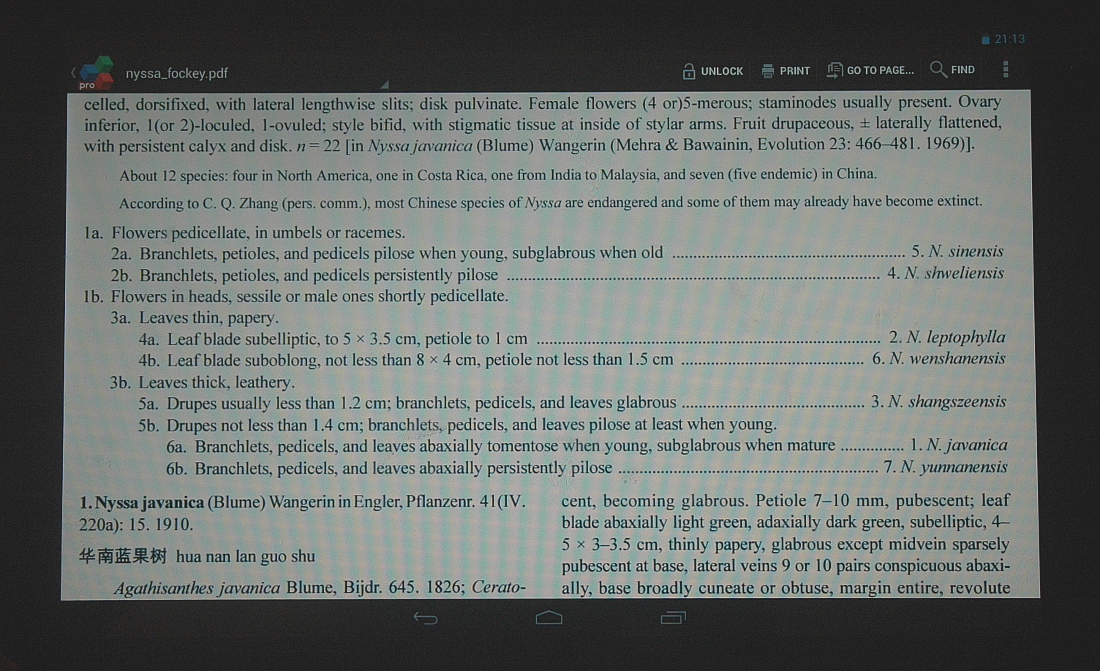
- Weakley's Flora of the Southern and Mid-Atlantic States: this remarkable modern (regularly updated) flora to the eastern US does of course contain a large number of cultivated species from the North American flora. Have a look at the different versions: http://www.herbarium.unc.edu/flora.htm and you will want a copy. It is 65MB but that is space well used, especially if the you also key plants native to the eastern US. Many experts contributed from leading universities and their application of both classic and recent taxonomic literature is spot on. I find it especially brilliant for keying out Quercus, Acer, Solidago, Aster, Myrica/Morella, Magnolia, carnivorous plants, and ferns.
- Jan De Langhe, Dendrologist, Ghent University Botanical Garden (cooperating with Arboretum Wespelaar): these are truly the finest woody plant keys available in any medium and are very recent in their revisions. The advantage here, besides the author's devotion to detail and practicality, is that newer species from the entire world (not just one flora) are covered and new taxonomic literature is incorporated into the revisions. Best of all, Jan's image database provides a wealth of high-resolution, quality content to support his keys and flesh out his species concepts. Everyone who ever writes a key has their own unique concepts of the broadness or narrowness of a species (sensu latu, sensu stricto, hybrid influence, grex, semispecies, protospecies, etc.) and the limits when dividing up other close taxa. I'd like to see more keys reinforced and informed by an image database done so very well in this project. Please visit: http://www.arboretumwespelaar.be/EN/Identification_keys_and_illustrations/Identification_keys/
- Here's
me working my way through Jan's superb birch key on the Note 4...screen
dimmed for easier reading. This phone has a 5.7 inch diagonal screen
and 2560 x 1440 pixel resolution so it works with fine print.
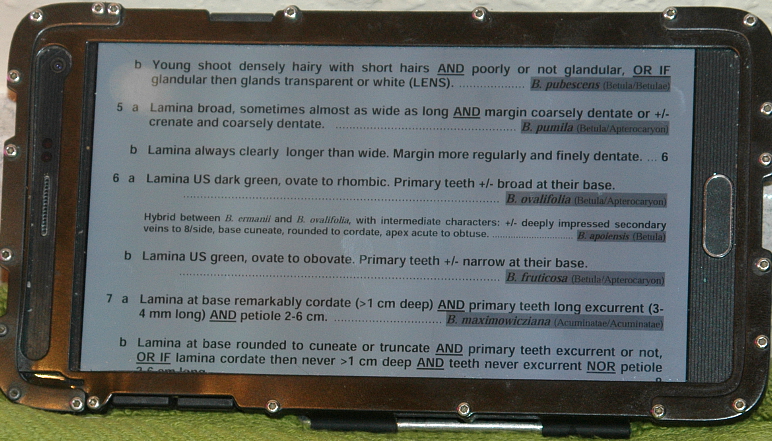
- Jan's
Castanea key on the 13.3 in. tablet. The swirls are artifacts of the
tablet's refresh rate not matching the camera's speed.The actual image is clean, white, and sharp.

- Turfgrass: the Colorado State key is a good starting place: http://www.cmgplantrx.colostate.edu/keys/vegetative%20ID%20key%20for%20Colorado1.pdf
- Some expert keys I would not want to be without:
- Cupressaceae: C. Schulz is superb for Cupressaceae: http://www.ruhr-uni-bochum.de/biodivpfl/pdfs/Schulz_2.pdf
- Juniperus: Robert Adams, the world's top Juniperus taxonomist ever is very generous with his work: http://www.juniperus.org/keys.html
- Quercus: Stein et. al. for Oaks: http://www.fs.fed.us/foresthealth/technology/pdfs/fieldguide.pdf
- Styrax: Lobdell dissertation: http://udspace.udel.edu/bitstream/handle/19716/12870/Matthew_Lobdell_thesis.pdf?sequence=1
- Larry Hatch of Cultivar.org (New Ornamentals Society): Your
editor here, Larry Hatch, has worked for almost 40 years on plant
identification keys since learning tree leaves as a little kid and
later studying horticultural
taxonomy at Cornell and North Carolina State University. CULTIVARS OF
WOODY PLANTS, my PDF encyclopedia of....you guessed it...just went over
4500 pages and 35 years so I have some idea of the morphological
diversity in gardens that is not found in our local woods or State
Park. Garden plant ID in a genus with 700 or 1800 cultivars, having
10-200 mutations for form and color in many combinations, is not
something a classically trained botanist dreams about. You can
follow the
 icons at http://www.cultivar.org
or try these sample linked below. Cultivar.org will be updated before
this page. I do not like the traditional dichotomous format for all
genera so some keys will have more than 2 choices per decision node. If
flowers can be blue, red, or white, why should that not be 3 choices?
Dichotomous pairings while friendly and familiar sometimes avoid the
obvious logic. My
keys also tend to include major cultivar groups if not the most popular
cultivars. Note the genus name in the filenames below....
icons at http://www.cultivar.org
or try these sample linked below. Cultivar.org will be updated before
this page. I do not like the traditional dichotomous format for all
genera so some keys will have more than 2 choices per decision node. If
flowers can be blue, red, or white, why should that not be 3 choices?
Dichotomous pairings while friendly and familiar sometimes avoid the
obvious logic. My
keys also tend to include major cultivar groups if not the most popular
cultivars. Note the genus name in the filenames below.... - https://members.tripod.com/~Hatch_L/cvaesculuskey.pdf
- https://members.tripod.com/~Hatch_L/cvakebiakey.pdf
- https://members.tripod.com/~Hatch_L/cvamelanchierkey.pdf
- https://members.tripod.com/~Hatch_L/cvastilbekey.pdf
- https://members.tripod.com/~Hatch_L/cvbaptisiakey.pdf
- https://members.tripod.com/~Hatch_L/cvcedruskey.pdf
- https://members.tripod.com/~Hatch_L/cvceltiskey.pdf
- https://members.tripod.com/~Hatch_L/cvhalesiakey.pdf
- https://members.tripod.com/~Hatch_L/cvcatalpakey.pdf
- https://members.tripod.com/~Hatch_L/cvcoryluskey.pdf
- https://members.tripod.com/~Hatch_L/cvperseakey.pdf
- https://members.tripod.com/~Hatch_L/cvphellokey.pdf
- https://members.tripod.com/~Hatch_L/cvrodgersiakey.pdf
- https://members.tripod.com/~Hatch_L/cvsisykey.pdf
- https://members.tripod.com/~Hatch_L/cvtsugakey.pdf
- European Garden Flora: this monumental work has the best keys for many genera and used Europe's best experts to work out many problems not tackled by older keys such as modern hybrids, new species concepts, and shifting nomenclature. Getting these keys on your device is not easy and I do not own the copyright so cannot share my own PDF files converted from online samples. Go to Google Books, https://books.google.com/books, (the search engine not the Play store), enter "european garden flora" (must have these quotation marks following by the name of a genus such as: "european garden flora" achillea . Google Books has permission to show some pages for some genera - not everything - and then I do a screen capture and save to PDF. This is alot of worth but worth it. The printed volumes are over $1000 if one is inclined to scan your own files from bound volumes. You will find the EGF is very useful if you want to key out tropical ornamentals, annuals, and diffucult groups of perennials.
- How to do screen capture with Google Books (that have no PDF download option) towards a PDF file: open the book sample to the page you want to have stored (typically a key) and use the + and - keys to show the text in the size you find comfortable reading. Use a screen capture application (I like PicPick, http://picpick.en.softonic.com/ as it's free and you can set up function keys) and save the sample as a JPG file. If using something with many columns such as the European Garden Flora, I may sample 2-3 screens per printed page to be sure I get the size and resolution I want. Then past these into a PDF file using a PDF creator tool (your choice of dozens there) and save as the genus or family you want. I have pasted a number of good keys from various onlne and print sources (the latter using my flatbed scanner) and save in a file called "perennialkeys" or "phloxkeys". Test them out on the device you plan to use before going too far. PDF readers will enlarge images saved with a screen capture but not all are equal. In fact, most PDF creators will try to lower the resolution of your JPG files unless you set options to maxmize JPG size and quality. PicPick and many of the better screen capture tools will save directly to PDF format and you can merge those files later as it minimizes the "sewing and stitching" together of many JPG files.
- Horticultural Flora of South-Eastern Australia: yes, is quite a practical and robust guide to many genera's traits, especially if you are in USDA zones 6-10 and need keys to lots more evergreen material. Roger's Spencer's work here is a tour de force in horticultural taxonomy and a valuable work for anybody in North Carolina, Florida, Texas, California, southern UK, the south of France, or other lands where less hardy woody plant material needs to be keyed out and understood. His knowledge of cultivars is amazing. Like the European Garden Flora I recommend getting the whole printed set but if you cannot then Google Books will let you sample some keys by searching there for: "horticultural flora australia". If your interests of late have run into down under flora and their complex species, these keys are more precious than Faberge eggs formed of Dodo bird eggs, encrusted with every known gem in all their known color variants in 30 carets or more, and solidly filled with the gold teeth of deceased botanists and farm hens.
- Bailey and Miller's Cyclopedia: this massive tome, once THE horticultural reference of all merits, is still useful for keying out plants when you are limited to species common up to WWII or so - nothing too new or wierd. Go to Google Books and search for "bailey cyclopedia". The several volumes can be downloaded but it takes lots of time and space.
- Oldies but Goodies, now in PDF: these free classics are free from Google Books and probably archive.org too. Clicks Google's little wheel icon to download in the format of your choice.
- Muenscher's Keys to Woody Plants: https://books.google.com/books?id=IPAnAAAAYAAJ&dq=plant%20identification%20keys&pg=PA3#v=onepage&q=plant%20identification%20keys&f=false
- Brown's Trees of New York State: https://books.google.com/books?id=SvEnAAAAYAAJ&dq=plant%20identification%20keys&pg=PA145#v=onepage&q=plant%20identification%20keys&f=false
- Agpar's Ornamental Shrubs (still very useful today and a little know treasure among garden plant keys): https://books.google.com/books?id=s5UYAAAAYAAJ&lpg=PA188&ots=FTnKidpLCj&dq=calycanthus%20species%20key&pg=PA192#v=onepage&q=calycanthus%20species%20key&f=false
- Trelease's Decorative Plantings: https://books.google.com/books?id=vg89AAAAYAAJ&dq=trelease&pg=PA10#v=onepage&q=trelease&f=false
- Trelease's Winter Botany: https://books.google.com/books?id=xWMAAAAAYAAJ&dq=trelease&pg=PA18#v=onepage&q=trelease&f=false
- Send us your PDF key links and we will include them after a quick review. They must be free to download for this page - but you can send us paid/purchased PDF key information for inclusion at cultivar.org as a commercial project. Those listings are free. We cannot include apps and websites without a PDF version because keys in this project must be downloadable and local without a live internet connection. Email Larry Hatch: ornamentals @ lycos.com and include GPIK in the subject line to get a quicker reply.
- Tell us what keys you need and we might write one: what genera are important to you and you'd find useful for portable ID work? We are limited to garden ornamentals please but tell us your 3-5 favs at the email address above in 10.
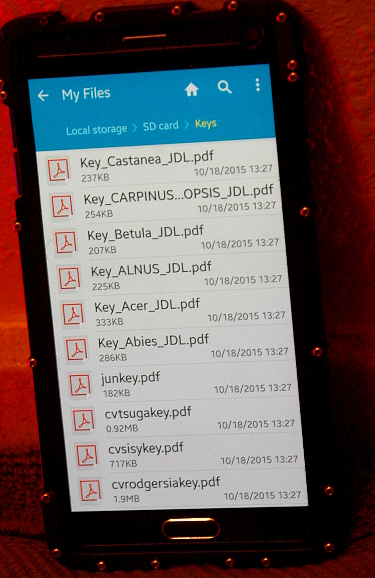
This is my menu (shortcut on the first apps screen) for these wonderful tools, showing some JDL (Jan de Langhe) keys, a junkey.pdf Juniperus key from Dr. Adams, and the cv prefix keys of my own from cultivar.org. These are all on local strorage (currently a 32GB SD card) in a folder called Keys. Your device has to have a PDF reader suitable for small screens (dozens of them are free) and you just touch the filename you want loaded. I turn my phone sideways for a better view in most cases. Currently my Local storage/SD Card/Keys menu has 44 files covering about 60 genera. I also have many floras in my main hortobotanical (I love that word coined by L.H. Bailey) reference shelf. I could probably key out 200-250 genera of garden interest with some digging.

These are my recommendations based on a few years out there in some rough spots:
- You will drop it eventually - so get a very strong protective case: in gardens, nurseries, and greenhouses, one is very apt to drop that expensive tab or phone on concrete, a stone block, metal hardware, orhalfway down some hill onto the fore-mentioned electronic device killers.
- Be rain ready: any photographer will do this already so maybe I'm preaching to the choir again. Whether it's a truly waterproof case, backpack, or just a simple trash bag you stuff into your pants, be prepared to shelter your camera, phone, tab, or other device when a hard rain comes without warning. Big gardens and wide nurseries tend to easy places to get caught without good shelter. The advantage of a larger case or backpack was you can keep dry some towels or papertowels to dry off any wet bits. Photographers of course will need microfiber clothes to keep the lens going again. Never let a stray drip sit on a piece of electronics as those can easily seep into a crease, gap, or banding within the next hour or two.
- Be seasonally smart: don't try to key out most woody plants in the spring because the leaf hairs (vestiture) are early, far too fuzzy and atypical, and raw. You need at least some foliage with maturity on it. Colors will not be right or set. Most keys are based on mature tissue traits. If the genus you are keying needs to have fresh flowers or fruit or seeds, plan your trip to an arboretum or large collection at a time when those tissues are available. It will be very frustrating if you are missing traits in lower sections of the key so give the key a very thorough breakdown for chronology and availability of the tissues. When I study hollies in the various collections, I always plan for a time when the fruit will be brightly colored and fresh but not too young either. Make notes and learn the seasonality of each genus for ID purposes.Two or three trips may be needed.
- Know the garden's tissue sampling policy and ask for help: most gardens and even public parks these days allow no cutting of anything, not one leaf or flower head. If you think you'll likely need a sample to take back for further ID work ask permission first before you arrive. I have found that asking about policies and permissions opens doors and the staff may be interested in your visit and assist in some very useful ways - like showing you plants otherwise off limits, new acquisitions, herbarium help, and access to their plant accession records. Sometimes they may even scan or press your specimens and send these on later! Make it worth their time with an upcoming article, thesis, dissertation, or book to offer credits. If you're a student with a ID project or a grad student doing hardcore key work, be sure to call or write ahead and get your faculity advisor(s) reaching out to them too. I've even been introduced to Directors of gardens and famous taxonomist only because I expressed my goals to a curator or tour guide. If you happen to have a book, degree project, or specialty plant website to mention or a professional business card...even better.
- If you're hoping to collect samples for a noted herbarium, always write ahead and get the herbarium's curator involved in the process. If you are not affiliated with your local university or garden herbarium do try to connect with them and share your goals. Many herbaria have very low budgets and would welcome a knowledgeable person like me or you to volunteer to help with ID questions. Many herbarium are part of programs such as Cooperative Extension in the US that mandate (yes require by law) they respond to public requests for scientific assistance - the 99 times out of 100 that is for basic plant identification.
- Be their researcher for the day or weekend. You'd be surprised how many times a garden has unanswered questions about a tree or twenty in terms of identification. If you take some time to handle their ID questions FIRST (and many of them will be easy), they are apt to really help with your genus interests. I remember getting into a large garden that charges $30 a head to enter only because I was part of a student group willing to key out some of their unknowns. I got 10 visits over the terms of that project.
- Gardens love students if you are serious, have a professor on their side that vouches for you, and don't just start ripping up leaves and flowers without an introduction. I was a student who went out to key out plants (before this modern portable ID stuff) and found many doors opened and sometimes had world famous experts come around to help me. I ended up discussing the ID of some confusing plants with scientists who had the same battle. Sometimes they had less expertise than little, over-acheiving me but much of the time these experts became mentors and inspriations with decades of knowledge they shared freely and without reserve. One time I ended up with a huge book about their identification and taxa verification process (Morton Arboretum, Floyd Swink) and other times got a royal tour of plant collections (public and private) by world-leading experts (US National Arboretum, March, Eisenbeiss, Dudley, Olsen). Staff love to discuss plant ID because only 0.1% of the garden visitors can communicate intelligently on the subject like you can!
- PRINCIPLE TWO: Every taxonomist and genus expert is desperately looking for young mentees, interns, any devoted souls willing or half interested to become the next generation to take up their taxa's cause, mission, and passion - and that includes new taxonomic technologies for identifcation. They don't expect plant societies, universities, or governments to fund the passion with their same level of devotion in this 21st century. Those grants and positions are apt to not exist when they move on. They might already be gone and they are funding their genus-based passion with slim funds, sometimes their own funds, or just volunteers who come their way.
- The portable taxonomic lab: I developed this years ago for my own advantage after I discovered my car could run a powerful power inverter out of the cigarette lighter. That meant I could not only power my laptop for the entire day but also a flatbed scanner USB-linked in the wide, stable back seat of my Dodge Intrepid and later a Chrysler 300 Touring. Just be careful the scanner is in padded case or secure bag so it doesn't bounce around while traveling. They are not as tough as cameras and have some thin, fragile light sources as well as lots of glass. Not while driving of course. Yes, you cut off a flower, fruit, or branch of leaves off some back road or garden and scan the darn thing with 9600 pixel perfection. The tissues are fresh, true to color, and these kinds of "live herbarium scans" are amonst the most valuable objects for plant ID. 4800-9600 pixels let's you see hairs and sometimes even stomates. Don't cut down your big, raw files until later because you may want several magnification versions or subsets of the tissue. Of course I apply my Nikons and Italian carbon fiber tripod to capture the overall perfection and context. I used to try a digital USB microscope from the Intrepid's back flanks (intrepid=fearless and sometimes I was) but never could get the images to be very useful.Probably a better, more expensive model would have worked or maybe I should have done all that stuff in my hotel room.
- Image, scan, and root: this is a triple win situation where you shot digital camera images of the plant's habit and macromorphology, then do a flatbed high-res scan, and have tissue to put into plastic bags for rooting or grafting when you get home. That provides three avenues of documentation that support each other.
- Live plant take home for later ID: Like any good roving horticulturists I had some plastic bags, bottles of water, potting soil, and an army surplus folding shovel in my trunk in case I wanted the subject of the examination to come home alive and be propagated.If you sampled this plant and it proves amazing and unique...why did you not try to get one to share with the world? PRINCIPLE THREE: A big part of the responsibility of identifying plants is finding new taxa, even if only a little different, documenting them for all eternity with best methods available at the time, finding a way to conserve and multiply them, and teaching the whole world why this is a new valuable entity.
- Profs, teachers, and instructors: be sure your students are ready for all of the above. I was lab instructor once and carried some extra trash bags to pass out to students carrying cameras and other portables.

- 10.28.2015 - added Azpen Android 13.3 in. tablet images
- 10.19.2015 - added Horticultural Flora of South-east Australia and link.
- 10.19.2015 - added this History section
- 10.19.2015 - send out first links for review among experts
 Copyright 2015. Laurence C. Hatch. All Rights Reserved.
Copyright 2015. Laurence C. Hatch. All Rights Reserved.Please visit www.cultivar.org for the entire horticultural taxonomy program including new cultivar registrations, a 4500 page woody plant encyclopedia, links to the best research, and much more.
You may use the the GPIK logo but only for purposes of providing a live link to this page or to cultivar.org or writing a feature on it.
Please ask before using any other images or more than 10 words of text.